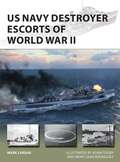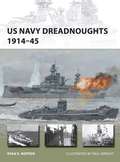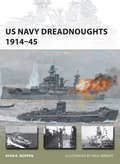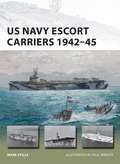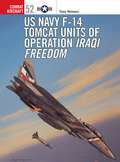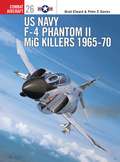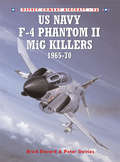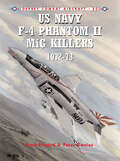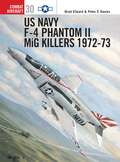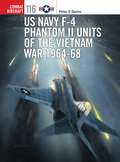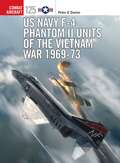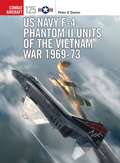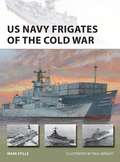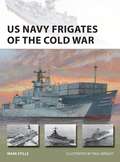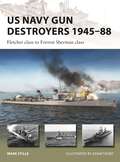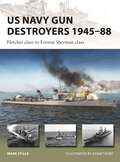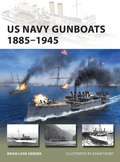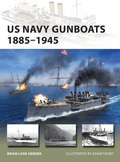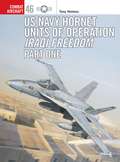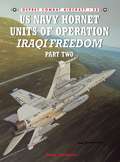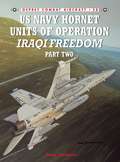- Table View
- List View
US Navy Destroyer Escorts of World War II (New Vanguard #289)
by Mark LardasThe Destroyer Escort was the smallest ocean-going escort built for the United States Navy – a downsized destroyer with less speed, fewer guns, and fewer torpedoes than its big brother, the fleet destroyer. Destroyer escorts first went into production because the Royal Navy needed an escort warship which was larger than a corvette, but which could be built faster than a destroyer. Lacking the shipyards to build these types of ships in Britain, they ordered them in the US. Once the US unexpectedly entered World War II, its navy suddenly also needed more escort warships, even warships less capable than destroyers, and the destroyer escort was reluctantly picked to fill the gap. Despite the Navy's initial reservations, these ships did yeoman service during World War II, fighting in both the Atlantic and Pacific, taking on both U-boat and Japanese submarines and serving as the early warning pickets against kamikazes later in the war. They also participated in such dramatic actions as the Battle of Samar (where a group of destroyers and destroyer escorts fought Japanese battleships and cruisers to protect the escort carriers they were shielding) and the capture of the U-505 (the only major naval vessel captured at sea by the US Navy). The destroyer escorts soldiered on after World War II in both the United States Navy and a large number of navies throughout the world, with several serving into the twenty-first century. This book tells the full story of these plucky ships, from their design and development to their service around the world, complete with stunning illustrations and contemporary photographs.
US Navy Dreadnoughts 1914–45 (New Vanguard)
by Paul Wright Ryan K. NoppenThe development of the US Navy's dreadnought battleships was a pivotal part of America's evolution into a true world power. By the beginning of World War I, the United States possessed the world's third largest navy, with ten dreadnoughts in service and four more under construction. By the end of World War II, the US Navy was the undoubted global superpower, despite initial crippling losses to its battlefleet at Pearl Harbor. Richly illustrated with archive photographs as well as a full cutaway of the world's only surviving dreadnought, this comprehensive and detailed title covers the technical characteristics and combat record of the US dreadnoughts throughout their long careers.
US Navy Dreadnoughts 1914–45 (New Vanguard #208)
by Paul Wright Ryan K. NoppenThe development of the US Navy's dreadnought battleships was a pivotal part of America's evolution into a true world power. By the beginning of World War I, the United States possessed the world's third largest navy, with ten dreadnoughts in service and four more under construction. By the end of World War II, the US Navy was the undoubted global superpower, despite initial crippling losses to its battlefleet at Pearl Harbor. Richly illustrated with archive photographs as well as a full cutaway of the world's only surviving dreadnought, this comprehensive and detailed title covers the technical characteristics and combat record of the US dreadnoughts throughout their long careers.
US Navy Escort Carriers 1942–45 (New Vanguard #251)
by Mark Stille Mr Paul WrightWhile not as famous as their larger and faster sister ships such as the Essex- and Yorktown-class carriers, escort carriers made an enormous contribution towards Allied victory both in the Pacific and Atlantic theatres. Rather than relying on size or speed, it was their sheer numbers that made them so effective. Indeed, the Casablanca-class escort carrier was the most-produced aircraft carrier in history. In partnership with the Royal Navy, they provided the backbone of Allied anti-submarine efforts in the Atlantic, finally and irrevocably turning the tide of the war against the U-boats in 1943. In the Pacific, they provided the air cover for the series of landings which led to the doorstep of Japan by 1945. These robust ships faced submarine, air, and even surface threats from the Japanese, but proved able to contend with everything thrown their way.Fully illustrated with contemporary photographs and unique specially commissioned artwork, this book shines a new light on these unjustly overlooked workhorses of the US Navy – ships that helped usher in the Allied victory over the Axis powers in the Atlantic and Pacific.
US Navy Escort Carriers 1942–45 (New Vanguard)
by Paul Wright Mark StilleWhile not as famous as their larger and faster sister ships such as the Essex- and Yorktown-class carriers, escort carriers made an enormous contribution towards Allied victory both in the Pacific and Atlantic theatres. Rather than relying on size or speed, it was their sheer numbers that made them so effective. Indeed, the Casablanca-class escort carrier was the most-produced aircraft carrier in history. In partnership with the Royal Navy, they provided the backbone of Allied anti-submarine efforts in the Atlantic, finally and irrevocably turning the tide of the war against the U-boats in 1943. In the Pacific, they provided the air cover for the series of landings which led to the doorstep of Japan by 1945. These robust ships faced submarine, air, and even surface threats from the Japanese, but proved able to contend with everything thrown their way.Fully illustrated with contemporary photographs and unique specially commissioned artwork, this book shines a new light on these unjustly overlooked workhorses of the US Navy – ships that helped usher in the Allied victory over the Axis powers in the Atlantic and Pacific.
US Navy F-14 Tomcat Units of Operation Iraqi Freedom (Combat Aircraft)
by Jim Laurier Tony HolmesSince the limited Desert Fox campaign against Iraq in December 1998, the Tomcat has been integral to virtually all combat operations involving the US Navy in the Arabian Gulf. Indeed, on every carrier deployment to the Persian Gulf since Desert Fox, the F-14 unit(s) on station has ventured into 'The Sand Box' over southern Iraq and prosecuted targets operating in contravention to United Nations security council resolutions. This book covers the F-14 Operation Iraqi Freedom actions against battlefield targets and integrated air defence sites, command and control centres, regime leadership targets and military installations in Baghdad, Tikrit, Mosul and Kirkuk.
US Navy F-14 Tomcat Units of Operation Iraqi Freedom (Combat Aircraft)
by Jim Laurier Tony HolmesSince the limited Desert Fox campaign against Iraq in December 1998, the Tomcat has been integral to virtually all combat operations involving the US Navy in the Arabian Gulf. Indeed, on every carrier deployment to the Persian Gulf since Desert Fox, the F-14 unit(s) on station has ventured into 'The Sand Box' over southern Iraq and prosecuted targets operating in contravention to United Nations security council resolutions. This book covers the F-14 Operation Iraqi Freedom actions against battlefield targets and integrated air defence sites, command and control centres, regime leadership targets and military installations in Baghdad, Tikrit, Mosul and Kirkuk.
US Navy F-4 Phantom II MiG Killers 1965–70 (Combat Aircraft)
by Jim Laurier Brad ElwardFor every American fighter pilot involved in the Vietnam War, the ultimate goal was to 'kill a MiG'. In eight years of conflict 43 Vietnamese Peoples Air Force aircraft were claimed by US Navy and US Marine Corps Phantom II crews, and one single ace crew produced. Navy Phantom IIs scored the first kills of the Vietnam War, in April 1965, as well as scoring the last in January 1973. This volume charts the successes of the navy fighter crews as they encountered 'MiGs, Missiles and AAA' over the jungles of North Vietnam.
US Navy F-4 Phantom II MiG Killers 1965–70 (Combat Aircraft #26)
by Jim Laurier Brad ElwardFor every American fighter pilot involved in the Vietnam War, the ultimate goal was to 'kill a MiG'. In eight years of conflict 43 Vietnamese Peoples Air Force aircraft were claimed by US Navy and US Marine Corps Phantom II crews, and one single ace crew produced. Navy Phantom IIs scored the first kills of the Vietnam War, in April 1965, as well as scoring the last in January 1973. This volume charts the successes of the navy fighter crews as they encountered 'MiGs, Missiles and AAA' over the jungles of North Vietnam.
US Navy F-4 Phantom II MiG Killers 1972–73 (Combat Aircraft #30)
by Brad Elward Peter E. DaviesThe second of two books on the Navy's Phantom II MiG killers of the Vietnam War, this book covers the numerous actions fought out over North Vietnam during the Linebacker I and II operations of 1972-73. No fewer than 17 MiGs were downed during this period, five of them by the Navy's sole aces of the conflict, Lts Randy Cunningham and Willie Driscoll of VF-96. Drawing on primary sources such as surviving Phantom II aircrew and official navy documentation, the author has assembled the most precise appraisal of fighter operations involving US Navy Phantom II units and those elusive MiGs ever seen in print.
US Navy F-4 Phantom II MiG Killers 1972–73 (Combat Aircraft)
by Jim Laurier Brad Elward Iain Wyllie Peter E. DaviesThe second of two books on the Navy's Phantom II MiG killers of the Vietnam War, this book covers the numerous actions fought out over North Vietnam during the Linebacker I and II operations of 1972-73. No fewer than 17 MiGs were downed during this period, five of them by the Navy's sole aces of the conflict, Lts Randy Cunningham and Willie Driscoll of VF-96. Drawing on primary sources such as surviving Phantom II aircrew and official navy documentation, the author has assembled the most precise appraisal of fighter operations involving US Navy Phantom II units and those elusive MiGs ever seen in print.
US Navy F-4 Phantom II Units of the Vietnam War 1964-68 (Combat Aircraft)
by Jim Laurier Gareth Hector Peter E. DaviesThe F-4 Phantom II is perhaps the most famous post-war fighter. Primarily used as a land-based fighter-bomber and reconnaissance platform, its naval origins and the immense contribution made to the US war effort in Vietnam by its original carrier-based versions began its legend.This title examines the unique aspects of the Phantom that made it so crucial to US Navy pilots during the Vietnam War – its massive engine power, long range, speed, the most powerful airborne search and fire-control radar installed in a fighter at the time, and of course its versatility as a ground attack and air-to-air platform. Packed with first hand accounts, unique profile artwork and rare photographs this is the history of one of the most important aircraft to be stationed on carriers off Southeast Asia during the war.
US Navy F-4 Phantom II Units of the Vietnam War 1964-68 (Combat Aircraft #116)
by Jim Laurier Gareth Hector Peter E. DaviesThe F-4 Phantom II is perhaps the most famous post-war fighter. Primarily used as a land-based fighter-bomber and reconnaissance platform, its naval origins and the immense contribution made to the US war effort in Vietnam by its original carrier-based versions began its legend.This title examines the unique aspects of the Phantom that made it so crucial to US Navy pilots during the Vietnam War – its massive engine power, long range, speed, the most powerful airborne search and fire-control radar installed in a fighter at the time, and of course its versatility as a ground attack and air-to-air platform. Packed with first hand accounts, unique profile artwork and rare photographs this is the history of one of the most important aircraft to be stationed on carriers off Southeast Asia during the war.
US Navy F-4 Phantom II Units of the Vietnam War 1969-73 (Combat Aircraft Ser. #125)
by Peter E DaviesAlthough the F-4 Phantom II was the most important fighter-bomber to see action with all three American services during the Vietnam War, it was essentially a U.S. Navy design, and the carrier-borne squadron crews were its main operators in combat. The aircraft pioneered the use of long-range, radar-guided missiles in combat, although the majority of its Vietnam missions involved ground-attack with a variety of innovative ordnance. From 1968 to 1973 the Phantom II was the standard U.S. Navy fighter in Southeast Asia, having replaced several other types. Its performance and versatility enabled it to perform a variety of different missions, and switch roles as necessary, in the assault on some of the world's most heavily defended territory. Including detailed colour profiles and first-person commentary from active participants in the F-4's naval combat history, this is a detailed study of the U.S. armed services' most famous post-war fighter.
US Navy F-4 Phantom II Units of the Vietnam War 1969-73 (Combat Aircraft)
by Jim Laurier Gareth Hector Peter E. DaviesAlthough the F-4 Phantom II was the most important fighter-bomber to see action with all three American services during the Vietnam War, it was essentially a U.S. Navy design, and the carrier-borne squadron crews were its main operators in combat. The aircraft pioneered the use of long-range, radar-guided missiles in combat, although the majority of its Vietnam missions involved ground-attack with a variety of innovative ordnance. From 1968 to 1973 the Phantom II was the standard U.S. Navy fighter in Southeast Asia, having replaced several other types. Its performance and versatility enabled it to perform a variety of different missions, and switch roles as necessary, in the assault on some of the world's most heavily defended territory. Including detailed colour profiles and first-person commentary from active participants in the F-4's naval combat history, this is a detailed study of the U.S. armed services' most famous post-war fighter.
US Navy Frigates of the Cold War (New Vanguard)
by Mark StilleThough they were never the most glamorous of warships, found US Navy frigates were frequently found on the frontlines of the Cold War at sea. These warships were the descendants of World War II's destroyer escorts, designed primarily to escort convoys. They specialized in anti-submarine warfare, but were intended to be numerous, tough, versatile, and well-armed enough to show US naval power around the world, performing roles that varied from intercepting drug-smugglers to defending aircraft carriers. When the Cold War turned hot, frigates were often there. It was a US Navy frigate, Harold E. Holt, that conducted the US Navy's first hostile boarding action since 1826 during the SS Mayaguez incident. Frigates were at the forefront of operations in the Persian Gulf during the Tanker War, with the frigate USS Stark suffering a notorious Exocet attack by Iraqi warplanes, and proving the Oliver Hazard Perry-class's legendary toughness. This book explains how the technology and design of frigates changed during the Cold War, how the classes were modified to keep up to date, and explores the many varied missions they performed during the Cold War and since.
US Navy Frigates of the Cold War (New Vanguard)
by Mark StilleThough they were never the most glamorous of warships, found US Navy frigates were frequently found on the frontlines of the Cold War at sea. These warships were the descendants of World War II's destroyer escorts, designed primarily to escort convoys. They specialized in anti-submarine warfare, but were intended to be numerous, tough, versatile, and well-armed enough to show US naval power around the world, performing roles that varied from intercepting drug-smugglers to defending aircraft carriers. When the Cold War turned hot, frigates were often there. It was a US Navy frigate, Harold E. Holt, that conducted the US Navy's first hostile boarding action since 1826 during the SS Mayaguez incident. Frigates were at the forefront of operations in the Persian Gulf during the Tanker War, with the frigate USS Stark suffering a notorious Exocet attack by Iraqi warplanes, and proving the Oliver Hazard Perry-class's legendary toughness. This book explains how the technology and design of frigates changed during the Cold War, how the classes were modified to keep up to date, and explores the many varied missions they performed during the Cold War and since.
US Navy Gun Destroyers 1945–88: Fletcher class to Forrest Sherman class (New Vanguard #322)
by Mark StilleAn illustrated history of the long Cold War careers of the US Navy's last gun destroyers, from the modernized World War II-era Fletcher-class to the Forrest Sherman-class. The finest American destroyers of World War II had surprisingly long careers into the Cold War and the missile age. The 175-strong Fletcher-class was the largest class of US Navy destroyers ever built, and most received some modernization after World War II. A handful were converted into ASW (Anti-Submarine Warfare) escorts and one was even converted into the US Navy's first guided missile destroyer. Many Sumner-class destroyers were also kept in service, with the last decommissioned in 1973. The Gearing class was the classic US Navy wartime destroyer to have a second Cold War career, some being modified into picket ships and others into ASW escorts. Ninety-five were extensively modernized under the Fleet Modernization and Rehabilitation (FRAM) program which allowed them to serve until 1980. The majority of these ships then saw service with foreign navies. However the story of Cold War gun destroyers is not just one of World War II relics. Commissioned in the 1950s, the 18 ships of the Forrest Sherman class were the US Navy's last all-gun destroyers, and were considered to be the pinnacle of US Navy gun-destroyer design. Later in their careers, most were modernized for ASW and antiair warfare. The virtually unknown Norfolk class was originally built as a destroyer leader and maximized for ASW but only two were modernized and the other three retired early. Many of these ships, such as USS Edson, Cassin Young, and Turner Joy, still survive as museum ships today.Using battlescene artwork, detailed illustrations and photos, this book explores the careers, modernizations, and roles of all these unsung Cold War stalwarts, the last gun destroyers of the US Navy.
US Navy Gun Destroyers 1945–88: Fletcher class to Forrest Sherman class (New Vanguard #322)
by Mark StilleAn illustrated history of the long Cold War careers of the US Navy's last gun destroyers, from the modernized World War II-era Fletcher-class to the Forrest Sherman-class. The finest American destroyers of World War II had surprisingly long careers into the Cold War and the missile age. The 175-strong Fletcher-class was the largest class of US Navy destroyers ever built, and most received some modernization after World War II. A handful were converted into ASW (Anti-Submarine Warfare) escorts and one was even converted into the US Navy's first guided missile destroyer. Many Sumner-class destroyers were also kept in service, with the last decommissioned in 1973. The Gearing class was the classic US Navy wartime destroyer to have a second Cold War career, some being modified into picket ships and others into ASW escorts. Ninety-five were extensively modernized under the Fleet Modernization and Rehabilitation (FRAM) program which allowed them to serve until 1980. The majority of these ships then saw service with foreign navies. However the story of Cold War gun destroyers is not just one of World War II relics. Commissioned in the 1950s, the 18 ships of the Forrest Sherman class were the US Navy's last all-gun destroyers, and were considered to be the pinnacle of US Navy gun-destroyer design. Later in their careers, most were modernized for ASW and antiair warfare. The virtually unknown Norfolk class was originally built as a destroyer leader and maximized for ASW but only two were modernized and the other three retired early. Many of these ships, such as USS Edson, Cassin Young, and Turner Joy, still survive as museum ships today.Using battlescene artwork, detailed illustrations and photos, this book explores the careers, modernizations, and roles of all these unsung Cold War stalwarts, the last gun destroyers of the US Navy.
US Navy Gunboats 1885–1945 (New Vanguard)
by Brian Lane HerderFor more than half a century, American gunboats were the ships often responsible for policing small crises and provided deterrence and fast-response capabilities around the world – showing the flag, landing armed parties, patrolling river and littoral areas, and protecting ex-pats. They were often the United States' most-visible and constant military presence in far-flung foreign lands, and were most closely associated with the Far East, particularly the Philippines and China. Most famous, of course, was the multinational Yangtze Patrol.Many US gunboats were built, purchased, or reassembled overseas, where they usually served out their entire careers, never coming within 7,000 miles of the national homeland which they served. Numerous gunboats were captured from the Spanish during the 1898 war, many being raised from shallow graves, refurbished, and commissioned into USN service.The classic haunt of US gunboats was the Asiatic Station of China and the Philippines. Gunboat service overseas was typically exotic and the sailors' lives were often exciting and unpredictable. The major operational theaters associated with the US gunboats were the pre-1898 cruises and patrols of the earliest steel gunboats, the Spanish-American War of 1898 (both the Philippines and the Caribbean), the guerilla wars of the early 20th century Philippines and Latin America, the Asiatic Fleet and Yangtze Patrol of the 1890s-1930s, and finally World War II, which largely entailed operations in China, the Philippines, the Dutch East Indies, Alaska, and on convoy routes. It was Japan's sudden 1941-1942 “Centrifugal Offensive” that effectively spelled the beginning of the end not just of most American gunboats, but also the century-old world order in Asia that had provided US gunboats their primary mission.
US Navy Gunboats 1885–1945 (New Vanguard)
by Brian Lane HerderFor more than half a century, American gunboats were the ships often responsible for policing small crises and provided deterrence and fast-response capabilities around the world – showing the flag, landing armed parties, patrolling river and littoral areas, and protecting ex-pats. They were often the United States' most-visible and constant military presence in far-flung foreign lands, and were most closely associated with the Far East, particularly the Philippines and China. Most famous, of course, was the multinational Yangtze Patrol.Many US gunboats were built, purchased, or reassembled overseas, where they usually served out their entire careers, never coming within 7,000 miles of the national homeland which they served. Numerous gunboats were captured from the Spanish during the 1898 war, many being raised from shallow graves, refurbished, and commissioned into USN service.The classic haunt of US gunboats was the Asiatic Station of China and the Philippines. Gunboat service overseas was typically exotic and the sailors' lives were often exciting and unpredictable. The major operational theaters associated with the US gunboats were the pre-1898 cruises and patrols of the earliest steel gunboats, the Spanish-American War of 1898 (both the Philippines and the Caribbean), the guerilla wars of the early 20th century Philippines and Latin America, the Asiatic Fleet and Yangtze Patrol of the 1890s-1930s, and finally World War II, which largely entailed operations in China, the Philippines, the Dutch East Indies, Alaska, and on convoy routes. It was Japan's sudden 1941-1942 “Centrifugal Offensive” that effectively spelled the beginning of the end not just of most American gunboats, but also the century-old world order in Asia that had provided US gunboats their primary mission.
US Navy Hornet Units of Operation Iraqi Freedom (Combat Aircraft)
by Tony Holmes Chris DaveyThe F/A-18 Hornet in its various guises was the 'universal soldier' of OIF, with around 250 seeing combat. Flown by various squadrons and groups, the Hornet attacked a range of targets including tanks of the various Iraqi Republican Guard units and government buildings housing elements of the Baath party regime. Apart from its ability to drop precision munitions such as laser-guided bombs, the Hornet was also capable of launching anti-radar missiles and acting as an aerial tanker and reconnaissance platform for other strike types. This book explores the Hornet's versatility which has enhanced its reputation as one of the world's leading strike-fighter aircraft.
US Navy Hornet Units of Operation Iraqi Freedom (Combat Aircraft)
by Tony Holmes Chris DaveyThis book explores the role of the US Navy Hornet units in the northern Iraqi campaign. These units were the first Navy Reserve unit to be mobilized since the Korean War, and their attacks were launched from carriers off the coast of Turkey. The conflict for these squadrons was very different from the campaign fought in southern Iraq: they worked almost exclusively with clandestine Special Forces teams from the US Army, Marine Corps, Navy SEALs, British and Australian SAS and Kurdish guerrillas. First-hand accounts accompany the indispensable role these units had in the battle to liberate Iraq.
US Navy Hornet Units of Operation Iraqi Freedom (Combat Aircraft #46)
by Tony Holmes Chris DaveyThe F/A-18 Hornet in its various guises was the 'universal soldier' of OIF, with around 250 seeing combat. Flown by various squadrons and groups, the Hornet attacked a range of targets including tanks of the various Iraqi Republican Guard units and government buildings housing elements of the Baath party regime. Apart from its ability to drop precision munitions such as laser-guided bombs, the Hornet was also capable of launching anti-radar missiles and acting as an aerial tanker and reconnaissance platform for other strike types. This book explores the Hornet's versatility which has enhanced its reputation as one of the world's leading strike-fighter aircraft.
US Navy Hornet Units of Operation Iraqi Freedom (Combat Aircraft #58)
by Tony Holmes Chris DaveyThis book explores the role of the US Navy Hornet units in the northern Iraqi campaign. These units were the first Navy Reserve unit to be mobilized since the Korean War, and their attacks were launched from carriers off the coast of Turkey. The conflict for these squadrons was very different from the campaign fought in southern Iraq: they worked almost exclusively with clandestine Special Forces teams from the US Army, Marine Corps, Navy SEALs, British and Australian SAS and Kurdish guerrillas. First-hand accounts accompany the indispensable role these units had in the battle to liberate Iraq.
